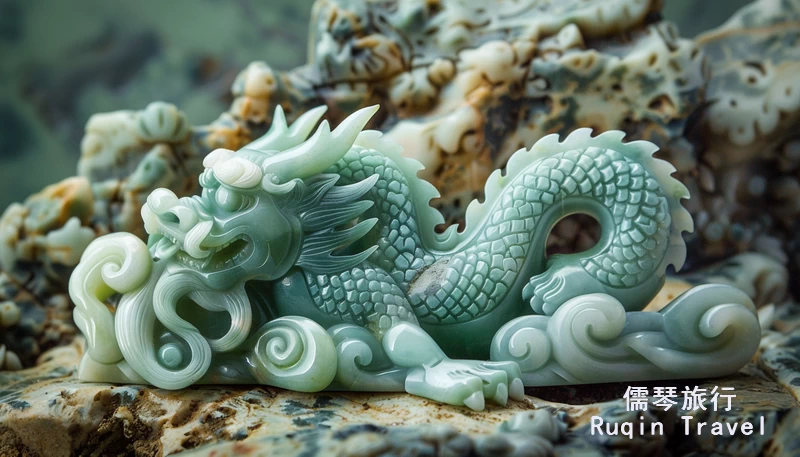Welcome to the fascinating world of Chinese jade culture! If you’re planning a trip to China, understanding the role of jade in Chinese traditions will enrich your travel experience. This precious stone, revered for centuries, is deeply embedded in Chinese history and daily life.
In this guide, we will explore the significance of jade, its various types, historical importance, and where you can buy authentic jade in China. Let’s embark on this cultural journey together!
History of Jade in China
Jade has been a part of Chinese culture for over 7,000 years. Initially, people used jade for tools and weapons. However, its beauty and toughness soon led to its use in rituals and ornamentation. The Neolithic period marked the beginning of jade’s importance in Chinese society. People believed jade had protective and healing properties, making it a prized material.
As time progressed, jade became a symbol of status and spirituality. During the Shang and Zhou dynasties, jade objects were buried with the dead, symbolizing immortality and a connection to the heavens. Jade’s association with virtues such as purity, righteousness, and wisdom solidified its status in Chinese culture. Today, jade remains a cherished symbol of Chinese heritage.
Jade in Chinese Traditions
In Chinese traditions, jade is more than just a beautiful stone. It holds deep cultural and spiritual significance. For example, jade is often given as a gift to convey good wishes and blessings. Jade pendants, bracelets, and rings are popular gifts during weddings, birthdays, and other significant events.
Moreover, jade is believed to have protective properties. Many Chinese people wear jade amulets to ward off evil spirits and attract good luck. This tradition stems from ancient beliefs that jade can absorb negative energy and promote health and longevity.
Jade also plays a role in traditional Chinese medicine. Jade rollers, used to massage the face, are thought to improve skin health and circulation. Additionally, jade powder is sometimes used in herbal remedies to enhance overall well-being.
Significance of Jade in China
Jade’s significance in China extends beyond its physical properties. It represents Confucian virtues such as righteousness, humility, and loyalty. Confucius, the famous Chinese philosopher, compared jade to a gentleman, emphasizing its moral and ethical symbolism.
In Chinese art, jade is often carved into intricate designs and sculptures. These creations depict mythical creatures, historical figures, and symbols of good fortune. Jade carvings are not only artistic masterpieces but also convey cultural stories and values.
Furthermore, jade is a symbol of social status and wealth. In ancient China, only the elite could afford jade ornaments and artifacts. This association with affluence continues today, as jade pieces are still considered valuable investments and treasured heirlooms.
Types of Chinese Jade
Chinese jade comes in two main types: nephrite and jadeite. Nephrite, the more traditional type, has been used in China for thousands of years. It is typically green, but can also be white, yellow, or brown. Nephrite is softer than jadeite but highly valued for its historical significance.
Jadeite, introduced to China from Burma in the 18th century, is harder and more vibrant in color. It comes in a range of hues, including green, lavender, red, and black. Imperial green jadeite is the most prized variety, known for its deep, translucent green color.
Both types of jade are esteemed in Chinese culture, each with unique characteristics and beauty. When buying jade in China, understanding these differences can help you appreciate the stone’s diversity and select pieces that resonate with you.
Ancient Chinese Jade Carvings
Ancient Chinese jade carvings showcase the artistry and skill of craftsmen throughout history. These carvings include ritual objects, personal ornaments, and decorative items. Common motifs in jade carvings are dragons, phoenixes, and other mythical creatures, symbolizing power, immortality, and harmony.
During the Han dynasty, jade burial suits were created for royalty and nobility. These suits, made of hundreds of jade pieces sewn together with gold or silver thread, were believed to protect the body in the afterlife. These intricate works of art highlight the cultural importance of jade in ancient China.
Additionally, jade bi discs, circular objects with a hole in the center, were used in religious ceremonies and as symbols of heaven. The craftsmanship and symbolic meanings behind these ancient jade carvings reflect the profound respect and reverence the Chinese have for jade.
Where to Buy Jade in China
When visiting China, there are several places to buy authentic jade. Jade markets and specialty stores offer a wide range of jade products, from jewelry to carvings. Beijing, Shanghai, and Hong Kong are popular cities with reputable jade shops.
The Hongqiao Pearl Market in Beijing is a well-known destination for jade shopping. Here, you can find jade pendants, bracelets, rings, and more. The market also offers the opportunity to learn about jade from knowledgeable vendors.
In Shanghai, the Shanghai Jade Buddha Temple is not only a spiritual site but also a place to purchase jade items. The temple features a jade market where you can find quality jade products and witness the craftsmanship involved in jade carving.
For those visiting Hong Kong, the Jade Market in Yau Ma Tei is a must-visit. This bustling market has numerous stalls selling jade jewelry, sculptures, and other artifacts. It’s an excellent place to find unique jade pieces and bargain for the best prices.
Jade Jewelry in China
Jade jewelry holds a special place in Chinese culture. It is worn not only for its beauty but also for its symbolic meanings. Jade bracelets, necklaces, rings, and earrings are popular accessories that convey good fortune, health, and protection.
One of the most cherished pieces of jade jewelry is the jade bangle. Worn on the wrist, jade bangles are believed to safeguard the wearer and bring peace and prosperity. These bangles are often passed down through generations, becoming treasured family heirlooms.
Jade pendants are also highly valued. They come in various shapes and designs, such as dragons, Buddha figures, and flowers. Each design carries its own symbolism, making jade pendants meaningful gifts for loved ones.
Chinese Jade Festivals
China celebrates jade through various festivals and events. The Xiuyan Jade Festival, held in Xiuyan County, Liaoning Province, is one of the most famous. This festival showcases jade carvings, jewelry, and sculptures from local artisans. Visitors can also participate in jade auctions and cultural performances.
Another notable event is the Hetian Jade Cultural Festival in Xinjiang. Hetian, known for its high-quality jade, hosts this festival to promote jade culture and trade. The festival features exhibitions, trade fairs, and jade carving competitions, attracting jade enthusiasts from around the world.
These festivals provide a unique opportunity to experience the vibrant jade culture in China. They offer insight into the craftsmanship, traditions, and significance of jade in Chinese society.
Authentic Chinese Jade
When buying jade, authenticity is crucial. Unfortunately, the market is filled with imitations and treated stones. To ensure you’re purchasing genuine jade, it’s important to buy from reputable dealers and understand the characteristics of real jade.
Authentic jade has a smooth, cold feel and a rich, vibrant color. It should also have a fine, even texture without cracks or impurities. When tapped lightly, real jade produces a distinctive, resonant sound.
Additionally, consider obtaining a certificate of authenticity from the seller. This document provides assurance that the jade is genuine and often includes details about the type and quality of the stone.
Chinese Jade Sculptures
Jade sculptures are masterpieces of Chinese art. These intricate carvings depict a wide range of subjects, from mythical creatures to everyday objects. Jade sculptors use their skill and creativity to bring the stone to life, creating works of art that are both beautiful and meaningful.
Common themes in jade sculptures include dragons, phoenixes, and landscapes. Each piece is carefully crafted to highlight the natural beauty of the jade, with attention to detail and precision. These sculptures are not only decorative but also carry cultural and symbolic significance.
Jade sculptures make excellent souvenirs and gifts, offering a glimpse into the rich artistic heritage of China. When purchasing jade sculptures, look for pieces that exhibit fine craftsmanship and high-quality jade.
Jade in Chinese Medicine
In traditional Chinese medicine, jade is believed to have healing properties. Jade rollers, used to massage the face, are popular for their supposed benefits in improving skin health and reducing wrinkles. These rollers have been used for centuries to promote relaxation and enhance circulation.
Jade powder is also used in herbal remedies. It is thought to have detoxifying properties and is sometimes added to beauty products and health supplements. While scientific evidence on jade’s medicinal benefits is limited, its use in traditional practices highlights its cultural significance.
Chinese Jade Myths and Legends
Jade is the subject of many Chinese myths and legends. One popular legend is that of the Jade Emperor, the supreme deity in Chinese mythology. According to the myth, the Jade Emperor governs the heavens and earth, and jade is his sacred stone.
Another legend tells the story of the Dragon and the Phoenix, symbols of harmony and balance. In this tale, the dragon and phoenix are often depicted with a piece of jade, representing their unity and power.
These myths and legends illustrate the deep connection between jade and Chinese culture. They add a layer of mystique and reverence to the stone, making it more than just a material object.
Visiting Jade Markets in China
Jade markets are a must-visit for anyone interested in Chinese jade culture. These markets offer a wide variety of jade products, from jewelry to sculptures. They also provide an opportunity to learn about jade from knowledgeable vendors and artisans.
In addition to Beijing, Shanghai, and Hong Kong, other cities with notable jade markets include Guangzhou and Kunming. These markets are bustling with activity and offer a unique shopping experience.
When visiting jade markets, it’s important to take your time and explore different stalls. Compare prices and quality, and don’t be afraid to negotiate. With patience and careful selection, you can find beautiful, authentic jade pieces that suit your taste and budget.
Famous Jade Pieces in China
China is home to many famous jade pieces, each with its own historical and cultural significance. One such piece is the Jadeite Cabbage, housed in the National Palace Museum in Taipei. This intricately carved jadeite sculpture resembles a head of cabbage with a locust and katydid perched on its leaves. It is considered a masterpiece of Qing dynasty jade carving.
Another renowned jade piece is the He Shi Bi, a legendary jade disk from ancient China. According to legend, this piece of jade was so valuable that it was traded for 15 cities during the Warring States period. The He Shi Bi eventually became the Imperial Seal of China, symbolizing the emperor’s authority.
These famous jade pieces are not only artistic treasures but also reflect the rich history and cultural heritage of China. They offer a glimpse into the craftsmanship and significance of jade in Chinese society.
Jade Craftsmanship in China
The art of jade carving is a highly respected craft in China. Jade craftsmen use traditional techniques passed down through generations to create intricate designs and sculptures. The process of jade carving is meticulous and requires great skill and precision.
First, the jade is carefully selected and inspected for quality. The stone is then shaped using diamond-tipped tools and polished to reveal its natural beauty. Detailed designs are etched into the jade, with craftsmen paying close attention to every detail.
Jade craftsmanship is an important part of China’s cultural heritage. Visiting a jade workshop allows you to witness this art form firsthand and gain a deeper appreciation for the skill and dedication involved in creating jade masterpieces.
Jade Museum Exhibits in China
China boasts several museums with impressive jade exhibits. These museums showcase the historical and cultural significance of jade through various artifacts and carvings.
The Palace Museum in Beijing, also known as the Forbidden City, has an extensive collection of jade artifacts. These include imperial seals, ceremonial objects, and decorative items from different dynasties. The museum’s jade exhibits provide insight into the role of jade in Chinese history and culture.
Another notable museum is the Shanghai Museum, which features a dedicated jade gallery. Here, visitors can admire jade pieces from the Neolithic period to the Qing dynasty. The gallery highlights the evolution of jade carving techniques and the cultural importance of jade in China.
These museum exhibits offer a comprehensive understanding of Chinese jade culture and are a must-visit for anyone interested in jade.
Modern Use of Jade in China
While jade has ancient roots, it continues to be relevant in modern China. Jade jewelry and ornaments are still popular, and new designs and styles are constantly emerging. Contemporary jade artists blend traditional techniques with modern aesthetics, creating pieces that appeal to today’s tastes.
Jade is also used in architecture and interior design. Jade tiles, countertops, and decorative elements add a touch of elegance and cultural significance to homes and buildings. Additionally, jade-themed fashion and accessories are gaining popularity, reflecting jade’s timeless appeal.
The modern use of jade in China demonstrates its enduring significance and versatility. It continues to be a symbol of beauty, status, and cultural heritage.
Chinese Jade for Good Luck
Jade is often associated with good luck and positive energy. Many Chinese people wear jade amulets or carry jade talismans to attract good fortune and protect against harm. These beliefs are rooted in ancient traditions and continue to be embraced in modern times.
Common jade amulets include pendants shaped like dragons, Buddha figures, and coins. Each design has its own symbolism and is believed to bring specific benefits. For example, a jade dragon is thought to bring power and success, while a jade coin symbolizes wealth and prosperity.
Giving jade as a gift is also a way to convey good wishes and blessings. Whether it’s a jade bangle for a loved one or a jade pendant for a friend, these gifts are meaningful tokens of goodwill and luck.
How to Identify Real Chinese Jade
Identifying real jade can be challenging, especially with the prevalence of imitations in the market. However, there are a few tips to help you distinguish genuine jade from fake stones.
First, examine the color. Real jade has a rich, vibrant hue that can vary from green to white, yellow, or lavender. The color should be even and natural-looking, without any artificial enhancements.
Next, feel the texture. Authentic jade is smooth and cold to the touch. It should also have a fine, even texture with no cracks or impurities.
Another method is the sound test. Tap the jade lightly with a hard object. Real jade produces a distinctive, resonant sound, unlike the dull sound of imitation stones.
Finally, consider getting a certificate of authenticity from a reputable dealer. This certificate verifies the jade’s authenticity and provides information about its type and quality.
Traditional Jade Workshops in China
Visiting a traditional jade workshop is a unique way to experience Chinese jade culture. These workshops offer a glimpse into the craftsmanship and techniques involved in jade carving.
In a jade workshop, you can observe skilled artisans at work, shaping and polishing jade into intricate designs. You may also have the opportunity to try your hand at jade carving, guided by experienced craftsmen.
Workshops are often located in areas known for jade production, such as Xiuyan and Hetian. These regions have a long history of jade craftsmanship and are renowned for their high-quality jade.
A visit to a traditional jade workshop provides insight into the artistry and dedication involved in creating jade masterpieces. It’s an enriching experience that deepens your appreciation for Chinese jade culture.
Chinese Jade Collectibles
Jade collectibles are highly prized for their beauty and historical significance. Collectors seek out jade pieces from different periods and regions, each with its own unique characteristics.
Ancient jade artifacts, such as bi discs and burial suits, are among the most sought-after collectibles. These pieces offer a glimpse into the rituals and beliefs of ancient China.
Modern jade collectibles include jewelry, sculptures, and decorative items. These pieces are valued not only for their aesthetic appeal but also for their craftsmanship and cultural significance.
Collecting jade is a rewarding hobby that connects you to China’s rich heritage. Whether you’re a seasoned collector or a novice, jade collectibles offer a tangible link to the past and a timeless symbol of beauty and virtue.
Chinese jade culture is a rich and fascinating aspect of China’s heritage. From its historical significance to its modern uses, jade continues to be a symbol of beauty, virtue, and cultural identity. As you explore China, take the opportunity to learn about jade, visit jade markets, and appreciate the artistry involved in jade craftsmanship. This guide provides a comprehensive overview of Chinese jade culture, helping you to appreciate the stone’s enduring allure and significance in Chinese society. Happy travels and happy jade hunting!
More China Cultural Insights
China is a country full of rich traditions, colorful festivals, and fascinating customs that have been passed down through generations. At China Cultural Insights by Ruqin China Travel, we want to help you experience the real China by understanding its culture.



